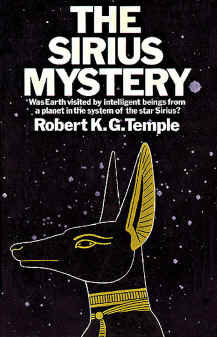The Sirius Mystery

Cover of the first edition
|
|
| Author | Robert K. G. Temple |
|---|---|
| Country | United States |
| Language | English |
| Subject | Dogon people |
| Genre | Non-fiction |
| Publisher | St. Martin's Press |
|
Publication date
|
1976 |
| Media type | |
| Pages | 440 pp. (softcover) |
| ISBN | |
| OCLC | 60154574 |
The Sirius Mystery is a non-fiction book by Robert K. G. Temple first published by St. Martin's Press in 1976. Its second, 1998, edition is called The Sirius Mystery: New Scientific Evidence of Alien Contact 5,000 Years Ago.
The book presents the hypothesis that the Dogon people of Mali, in west Africa, preserve a tradition of contact with intelligent extraterrestrial beings from the Sirius star system.
These beings, who are hypothesized to have taught the arts of civilization to humans, are claimed in the book to have originated the systems of the Pharaohs of Egypt, the mythology of Greek civilization, and the Epic of Gilgamesh, among other things. Temple's theory was heavily based on his interpretation of the work of ethnographers Marcel Griaule and Germaine Dieterlen. A substantial bulk of The Sirius Mystery consists of comparative linguistic and mythological scholarship, pointing out resemblances among Dogon, Egyptian and Sumerian beliefs and symbols. Greek and Arab myths and words are considered to a lesser extent.
The "mystery" that is central to the book is how the Dogon allegedly acquired knowledge of Sirius B, the white dwarf companion star of Sirius A, invisible to the naked eye. Temple did not argue that the only way that the Dogon could have obtained what he understood to be accurate information on Sirius B was by contact with an advanced civilization; he considered alternative possibilities, such as a very ancient, advanced, and lost civilization that was behind the sudden appearance of advanced civilization in both Egypt and Sumeria. He personally found the theory of alien contact more convincing, but he did not claim certainty about it. Noah Brosch explained in his book Sirius Matters that cultural transfer could have taken place between 19th century French astronomers and Dogon tribe members during the observations of the solar eclipse on 16 April 1893. The expedition, led by Henri Deslandres, stayed in the field for five weeks and it is reasonable that during this time many contacts with the locals took place, and that relatively modern astronomical knowledge was then transferred.
...
Wikipedia
